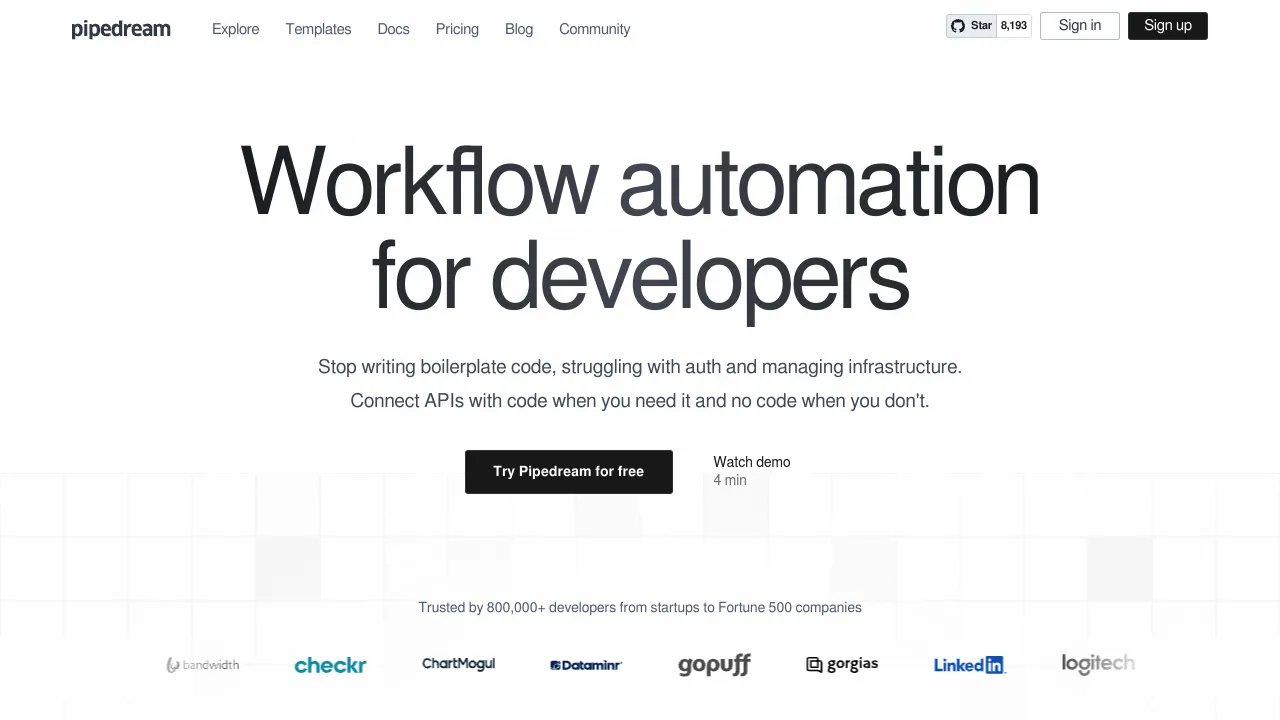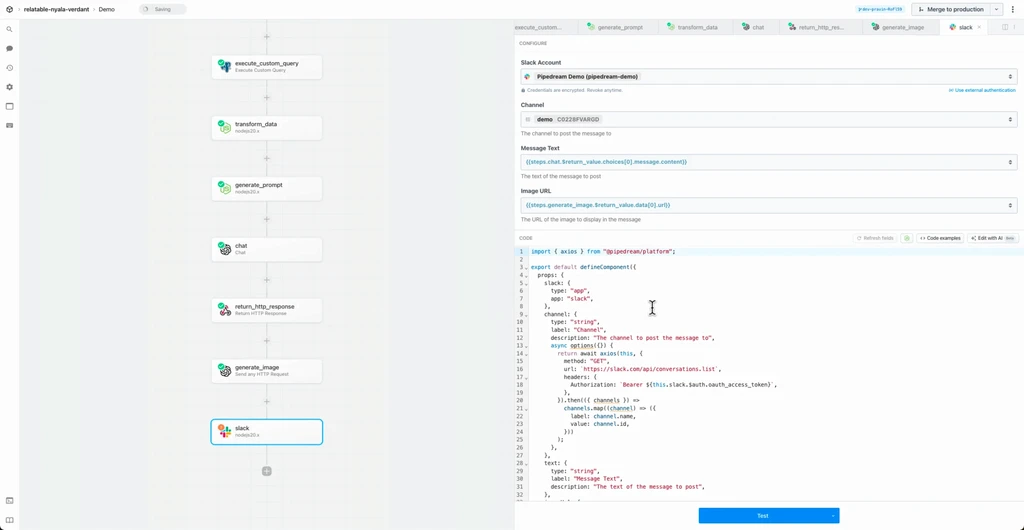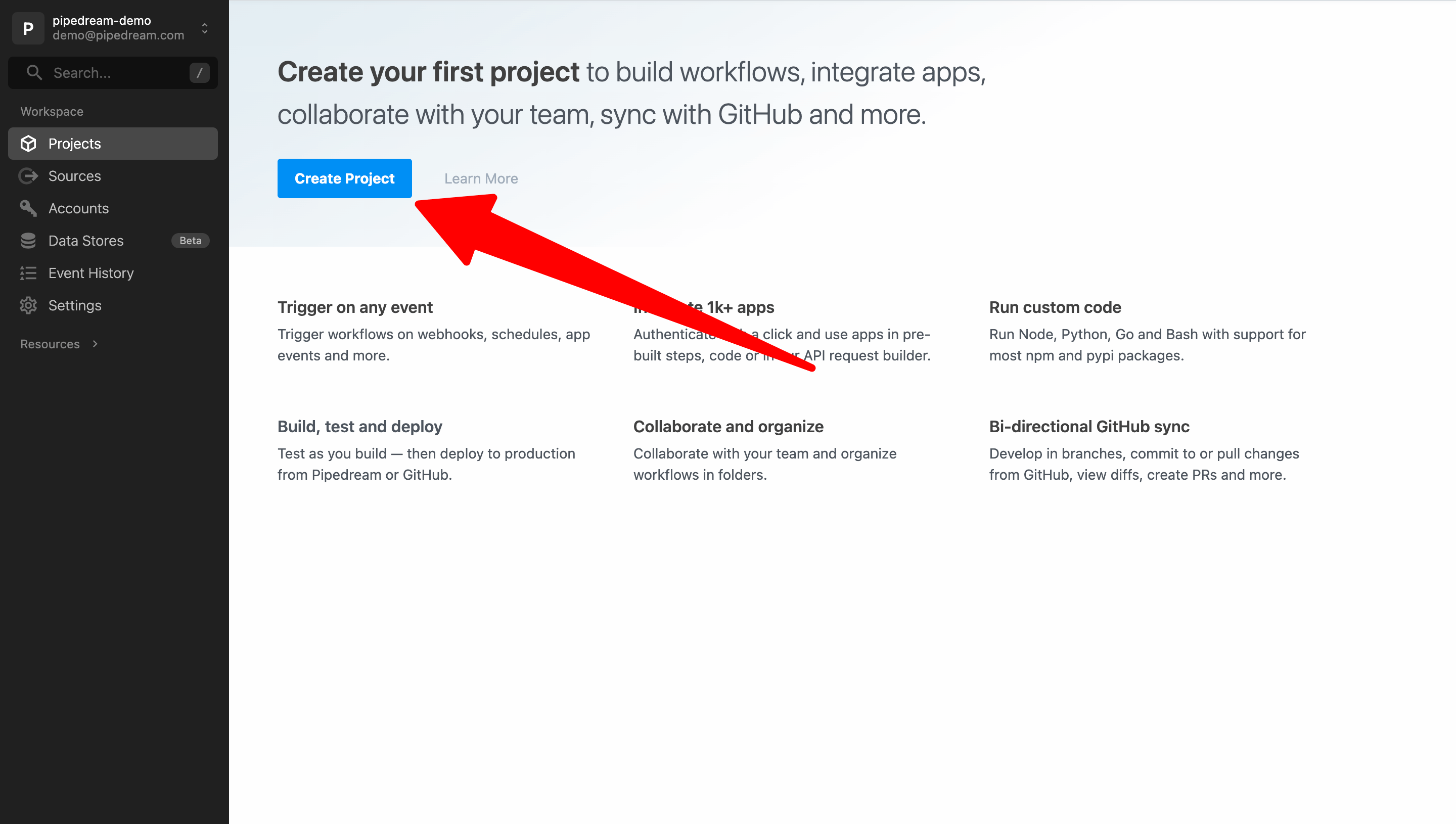Pipedream: Open-Source Automation for Developers
Researcher in mindfulness and its effects on productivity.

Researcher in mindfulness and its effects on productivity.

— in Productivity
— in Productivity
— in Mindfulness
— in Stress Management
— in Productivity
Pipedream is an integration platform designed for developers to connect APIs, AI, and databases. It allows building powerful applications with code-level control, but also offers no-code options. Pipedream is trusted by over 800,000 developers, from startups to Fortune 500 companies.

Pipedream stands out as a source-available platform for automating processes. It is designed to be a fast way to automate any process that connects APIs. This platform provides developers with the tools to build complex workflows.
Pipedream's core functionality revolves around its serverless runtime and workflow service. It provides source-available triggers and actions for hundreds of integrated apps. This allows for one-click OAuth and key-based authentication for over 2,000 APIs. Developers can use tokens directly in code or with pre-built actions.
Pipedream combines the flexibility of coding with the ease of no-code solutions. It enables developers to write production code quickly with built-in state management, authentication, observability, and error handling. Unlike some platforms, Pipedream doesn't hide the complexity of programming but improves the experience. It lets you use JavaScript or Python code within workflows.
The open-source nature of Pipedream brings several advantages to its users. It is not fully open source, but rather source-available, offering a unique blend of transparency and control. This approach fosters a collaborative environment.
With Pipedream's source-available license, users can access, modify, and redistribute the source code. This level of transparency allows developers to understand exactly how each component functions. It also provides the ability to customize and extend the platform as needed.
Pipedream encourages community contributions through its component registry on GitHub. Developers can contribute new components or modify existing ones. This community-driven approach ensures continuous improvement and innovation on the platform. Pipedream’s community is active and responsive, providing support and feedback.
Pipedream's architecture allows for significant customization and extensibility. Developers can use pre-built components or create their own custom actions and triggers. The ability to integrate custom code provides flexibility to handle unique and complex automation requirements.
When choosing an automation platform, comparing Pipedream with alternatives is essential. Each platform has its strengths and is suited for different use cases. Here’s a look at how Pipedream stacks up against some of the popular options.
Zapier is a mainstream no-code automation tool focused on ease of use. It offers a vast library of app integrations. However, Zapier can be expensive, especially for complex workflows. It also has limitations on custom code execution and npm package usage. Pipedream is more developer-centric, providing greater control with JavaScript and Python and the ability to use external packages. While Zapier is easier to start with, Pipedream offers more power and flexibility for developers. Pipedream is also often more cost effective for complex workflows.
Make (formerly Integromat) is another versatile automation platform. It is known for its visual workflow builder. While Make is powerful, it lacks native support for custom JavaScript. It also requires using an external solution for custom code. Pipedream, on the other hand, treats JavaScript as a first-class citizen. It allows developers to use custom code directly in their workflows. Make is a good middle ground, while Pipedream is more geared towards developers who need low-level control.
Other notable alternatives include n8n, which is an open-source platform focused on flexibility and self-hosting. Latenode offers a low-code platform with custom code support, and Relay.app focuses on ease of use with AI integration. Each of these platforms has unique strengths. The choice depends on the specific needs of the user.
| Feature | Pipedream | Zapier | Make (Integromat) | n8n |
|---|---|---|---|---|
| Target User | Developers | Non-technical users | Both technical and non-technical | Developers |
| Code Support | Native JS/Python | Limited JS/Python | External JS module | Native JS |
| Pricing | Pay-per-execution | Pay-per-task | Pay-per-operation | Open-source, self-hosted or cloud |
| Complexity | Complex workflows | Simple to moderate | Moderate to complex | Complex workflows |
| Ease of Use | Steeper learning curve | Very user-friendly | Moderate learning curve | Moderate learning curve |
Pipedream is used across various use cases, from simple integrations to complex automations. It is especially beneficial for tasks that require custom logic or API integrations. Here are some examples of how it can be used.
Pipedream excels in integrating webhooks and APIs. It can be used to connect different services and automate data transfers. For example, you can use Pipedream to trigger a workflow when a webhook is received. Then send that data to another application via its API.
Pipedream can automate tasks involving databases. It can be used to query databases on a schedule, or trigger actions based on database events. This allows for the automation of data backups, updates, and more.
Pipedream is great for creating custom notifications and alerts. It can monitor various systems and send notifications via email, Slack, or other platforms. This ensures that you are promptly informed about important events or changes.
Pipedream can integrate with AI and machine learning services. It can be used to process data with AI models, or trigger actions based on AI-generated results. This allows for the creation of intelligent and automated workflows. For example, it can be used to perform sentiment analysis on text data or to generate personalized content.

Getting started with Pipedream is straightforward. It involves setting up your first workflow and leveraging its pre-built components. You can also customize your workflows with code.
To set up your first workflow, you need to sign up for a free account. Then, you can use the visual workflow builder to create a new workflow. You can start with a trigger, such as a webhook or a scheduled event. Then, add actions to process the data and perform the desired tasks.
Pipedream offers a wide range of pre-built components, including triggers and actions for various apps and services. These components can be used as building blocks for your workflows. They can significantly reduce the amount of code you need to write.
Pipedream allows you to customize your workflows using JavaScript or Python. You can add code steps to perform complex logic or data transformations. This flexibility makes Pipedream suitable for a wide range of automation needs.
Pipedream uses a source-available license. This is different from a fully open-source license like MIT. This license provides both benefits and limitations for users.
The Pipedream Source Available License allows users to access, modify, and redistribute the source code. However, it restricts the use of the code in building competitive products. This means you cannot use Pipedream components in a SaaS integration platform.
The source-available license encourages contributions while protecting the platform's core business. Users can contribute new components and modify existing ones. This helps improve the platform for the entire community.
The license ensures that Pipedream can sustain its development and growth. By preventing the use of its code in competing products, Pipedream protects its investment in the platform. This allows it to continue providing a free and powerful automation tool for developers.
Pipedream has a strong community and offers various support resources. These resources are essential for users who need help or want to contribute.
The Pipedream community is active and welcoming. It includes forums, Slack channels, and social media platforms. Users can connect with other developers, ask questions, and share their experiences.
Pipedream provides comprehensive documentation and tutorials. These resources help users understand the platform's features and capabilities. They also guide users through the process of building and deploying workflows.
Users can report bugs and request features via Pipedream's GitHub repository. This direct line of communication with the development team ensures that issues are addressed promptly. It also allows for continuous improvement of the platform.
Pipedream offers a generous free tier and scalable options for production use. This makes it accessible to both small projects and large-scale applications.
Pipedream's free tier includes 3 active workflows, unlimited users, 3 connected accounts, and 300 credits. This allows users to explore the platform and build simple automation workflows without any cost.
Pipedream is designed to scale for production use. The platform processes billions of events and is built for high-volume applications. It can handle complex workflows and integrations efficiently.
Pipedream is a cost-effective solution for automation. It charges based on compute usage, rather than the number of steps. This can be significantly cheaper than other platforms for complex workflows. Pipedream offers a transparent pricing model.
Pipedream is continuously evolving, with planned features and improvements. The platform's future is closely tied to the role of open-source in automation. It has a long-term vision for empowering developers.
Pipedream has several planned features and improvements, including enhanced support for Python and other programming languages. The platform is committed to improving its user experience. It also plans to expand its integration library.
Pipedream believes in the power of open-source in automation. It aims to foster a collaborative environment where developers can contribute and benefit from shared resources. The platform is committed to transparency and community-driven development.
Pipedream's long-term vision is to become the leading platform for developer-centric automation. It aims to empower developers to build powerful integrations quickly and efficiently. The platform is committed to innovation and providing a sustainable solution for the developer community.
Key Takeaways:
This blog post provides a comprehensive overview of Pipedream. It covers its features, benefits, comparisons with alternatives, and future vision. It also includes examples, getting started tips, and information about its community and support.